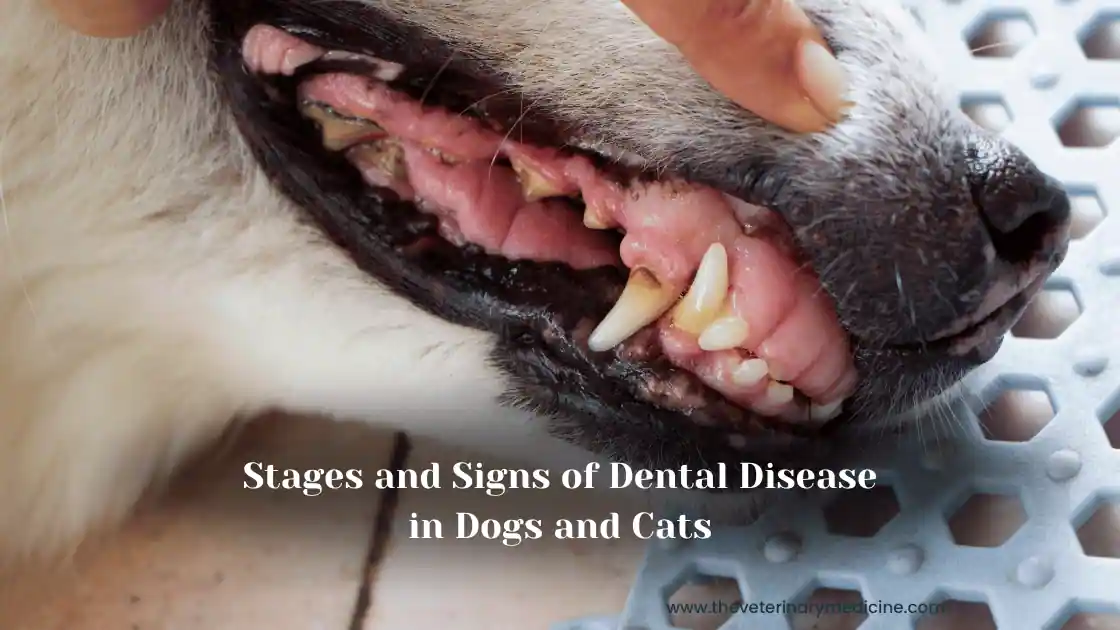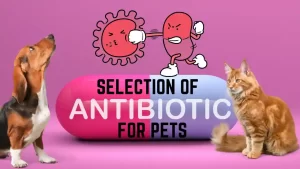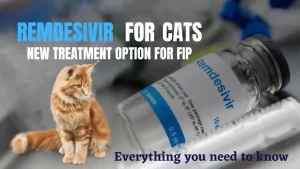Management of Dental Disease in Pets
Dental diseases are common in pets and by the age of 3 years, 4 out of 5 have some stages of dental disease. Cats suffer less in comparison to dogs but small breeds in dogs are more likely to develop periodontal diseases. Normal teeth have uniform white colour and light pink colour of gums. Improper care of dental hygiene in dogs and cats may lead to plaque, tartar, dental bone loss, gingivitis, bad breath and difficulty in eating or much more. Recognising warning signs dental diseases in pets is the first step for management.
How dental disease starts setting up in pets:
Everyday eating causes deposition of food particles, bacteria and saliva on tooth surface. Plaque is invisible biofilm created by bacteria on tooth surface, above and below gum line. Over the time plaque thickens, mineralises, hardens and gets converted into tartar. Rough dental surface allows more biofilm accumulation, tartar formation, dental decay, infection and sometimes tooth abscess. This causes inflammation of gums, creates periodontal pockets (gap between tooth surface and gum). Between the tartar and teeth or gum surface bacterial action causes gingivitis, bad breath, bleeding, loss of bone and if left untreated then can lead to systemic problems (heart, liver, kidney). Factors affecting dental diseases and oral health are genetics, breed, age, diet, oral hygiene and concurrent health issues. Some breeds like Yorkshire, Greyhound, Whippets, Pugs, Shih Tzus, Bull Dogs are more prone due to shape of their mouth.
In short, the stages of dental disease are:
- Food and bacteria form a biofilm called plaque on the teeth.
- Plaque mixes with minerals and saliva to harden and forms tartar.
- The tartar causes gingivitis (inflammation and infection of the gumline), which causes the gums to recede from the teeth.
- The bone surrounding the tooth roots becomes affected and periodontal disease starts setting.
Signs of dental disease in dogs and cats:
- Plaque (yellow deposit, discolouration of teeth)
- Tartar (deposition of thick layer of plaque and organic material)
- Difficulty in chewing or dropping food while chewing
- Prefers chewing with one side or less affected side of mouth
- Changes in feeding behaviour (prefers soft chew or food)
- Reluctance to eat or slow eating
- Refusal to play with toys, tugs and fetch (due to pain)
- Bad breath (Halitosis)
- Inflammation of gums (gingivitis)
- Bleeding from gums or mouth
- Drooling (excessive salivation -stringy thick saliva)
- Dental abscess
- Facial swelling or loss of symmetry of jaw
- Loose or broken tooth
- Pain / Pawing or rubbing at the face or mouth
- Weight loss
- Sudden change in behaviour (aggressive or withdrawn)
Inability to open or close mouth properly
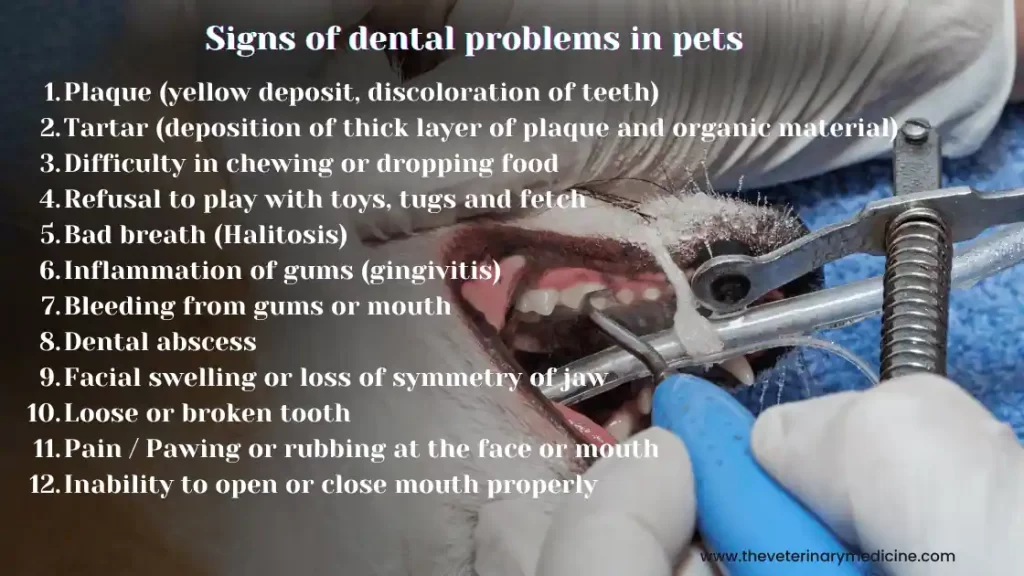
What is periodontal disease:
Periodontal disease refers to the infection and inflammation of the tissues surrounding the teeth, known as the periodontium. This periodontium consists of four components: the gingiva (gums), the cementum (the root surface covering), the periodontal ligament (which connects the tooth root to the bone), and the bone around the tooth.
The disease typically begins with gingivitis, an inflammation of the gums. If not treated, the infection can progress deeper into the tooth socket, leading to the destruction of bone. Eventually, this can cause the tooth to become loose and potentially fall out.
Periodontal disease can have additional complications due to bone loss, such as oronasal fistula (a hole connecting the mouth to the nose), jaw fractures, and abscesses with draining tracts that may appear in the mouth, on the face, or under the chin. Research suggests that bacteria from severe oral infections can enter the bloodstream and may be linked to health issues in major organs like the heart, liver, and kidneys.
Stage 0: No disease
Healthy pink gums and teeth. No sign of gingival inflammation and dental plaque formation.
No action needed. Dental brushing or water additives can be used for prevention of dental disease.
Stage 1 Dental Disease: Mild Gingivitis and Plaque
Margin of attached gingival (gum) line is inflamed and swollen. Mild plaque and calculus deposition. Plaque covering teeth (less than one third) without bone support loss.
Dental scaling / Treatment can reverse condition. Brush your pet’s teeth regularly and feed special food or treats for prevention.
Stage 2 Dental Disease: Advanced Gingivitis and Early Periodontitis
Entire attached gum is inflamed and swollen. Pocket formation between tartar and gum. Mouth is painful and odour begins to be noticeable due to volatile sulphur compounds. Mild bone support loss (more than 25%).
Professional treatment (dental scaling) is recommended. Gum tissue and tooth are cleaned, rinsed and treated with a gel. Home dental care suggested by your vet can prevent this from becoming irreversible.
Stage 3 Dental Disease: Moderate Periodontitis
Cherry red gums and bleeding is noticeable. Attached gum is being destroyed by infection and calculus (tartar) slowly. Deepening of pocket between tartar and gum. Sore mouth affects eating and behaviour. Bleeding and bad breath is present. Moderate bone support loss (25 to 50%) is evident.
It is the beginning of periodontal disease and may be irreversible. Dental scaling is strongly recommended along with antibiotics and pain medications.
Stage 4 Dental Disease: Advanced Periodontitis
Chronic bacterial infection is destroying the gum, tooth and bone at this stage. Bleeding gums, mobile teeth and very bad breath due to volatile sulphur compounds are observed. More deepening of pocket between tartar and gum due to significant loss of gingiva and bone support (>50%).
Bacteria may be spreading throughout the entire body via the bloodstream and may damage the kidneys, liver and heart.
Dental scaling is strongly recommended with tooth extraction if needed. Antibiotics and pain medications are necessary at this stage for management.
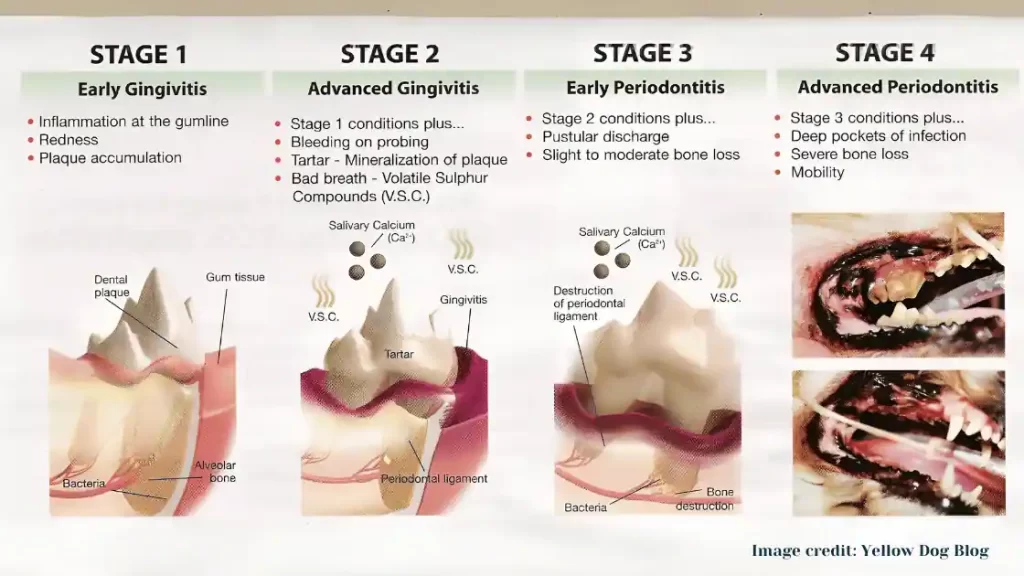
What is difference between gingivitis and periodontal disease?
Gingivitis is a milder and reversible form of gum disease affecting only the gums, periodontal disease is a more severe, often irreversible condition that damages the tissues and bone supporting the teeth. Stage 2 and 3 of periodontal disease can’t be reversed, but with the right care and management, the disease can be prevented from advancing to Stage 4.
How to diagnose dental problems in pets:
Signs and symptoms discussed above in the post like dental discolouration, inflamed gingiva, tartar, bad breath, mal-aligned tooth, pain are most common in pets suffering with dental problems. Full mouth radiographs are helpful in assessment of anatomy of tooth (roots and bone structure).
How to manage or treat dental problems in pets:
You can help your pet by staying proactive to any oral health issues you may observe. Dry food, dental diets can reduce formation of plaque and tartar. If you see any change or signs of dental disease then schedule a consultation with your vet. Attempting to brush in advance stages of dental diseases can increase pre-existing inflammation and discomfort. Brushing habit can be developed from puppyhood or gradually with positive reinforcement and small steps.
For prevention of periodontal diseases following things can be done according to stages:
- Dental scaling
- Dental brushing
- Pain killers
- Antibiotics
- Tooth extraction
- Dietary changes
- Annual dental exams
- Specialised food and treats
Remember that proactiveness and prompt action is the key for management of oral hygiene in pets. Dental scaling can provide immediate relief and improvement in the condition but without post scaling management bacteria again starts forming plaque and starts turning into tartar. Brushing with toothpaste, dental water additives, dental gels, dental diets, dental chews, dental toys like multiple things can be tried to effective management.
How to brush your dog’s or cat’s teeth:
Begin with simply running your finger from outside on the lips once and give a reward. Then gradually start running your finger along the gums and reward (treat or toy).
Once the pet is comfortable with initial steps then put some toothpaste or gel on finger and just apply on teeth and leave. Then approach towards brushing action with paste. Start using pet dental brush (silicone or bristles) depending on the comfort of your pet.
Remember that successful prevention of dental / periodontal disease requires both daily dental brushing at home and regular professional veterinary cleaning (scaling) under general anaesthesia. Tooth extraction like things due to plaque/ tartar deposition is end stage and purely a result of negligence.
What happens if dental disease left untreated?
Common complications of untreated dental disease are pain, bleeding and infection. As the support structures are lost, teeth can become loose, painful, and may eventually fall out. Tooth root abscesses, which are pockets of pus from infection, can also form, causing pain, pus drainage in the mouth, or cheek swelling near the eye.
Periodontal disease not only causes local issues in the mouth but can also impact the entire body, making your dog very ill. The bacteria around the tooth root can enter the bloodstream (bacteremia), leading to microscopic damage to the kidneys, heart muscle, and liver.
Conclusion:
Dental disease is prevalent in pets, with most dogs and cats showing signs by the age of three years. Small dog breeds are more susceptible in comparison to large breeds and cats. Dental disease starts with plaque, which hardens into tartar, leading to gingivitis, periodontal disease, and potential tooth loss. Symptoms include bad breath, difficulty eating, inflamed gums, and tooth abscesses. If untreated, it can cause systemic issues like heart and kidney problems. Management includes regular dental care, professional cleanings, and possibly antibiotics and extractions. Preventative measures include brushing, dental diets, and annual checkups. Gingivitis is reversible, but advanced periodontal disease is not. Early intervention is crucial so if you see signs of dental disease consider scheduling an appointment with your veterinarian.


